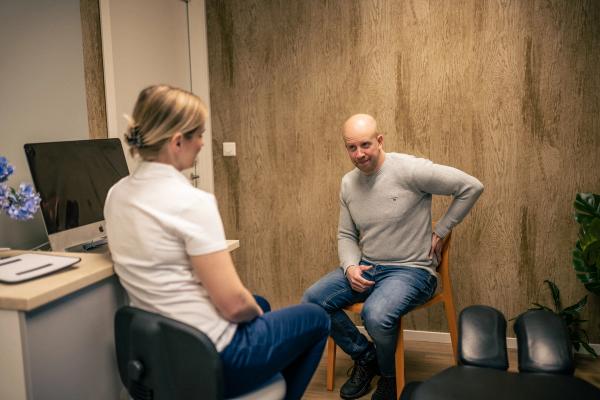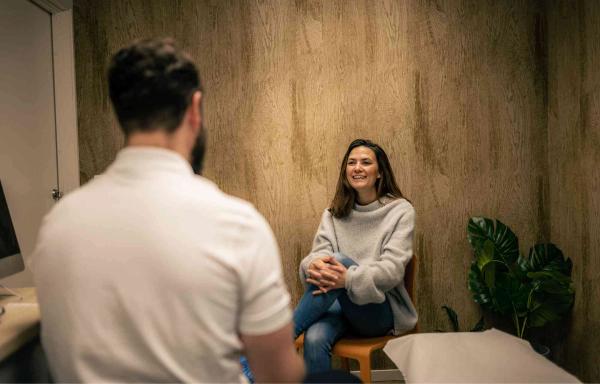Osteoarthritis in the back
Osteoarthritis of the back, also known as spinal osteoarthritis, is a condition that affects the spinal vertebrae and intervertebral discs. It typically develops over time due to aging and wear and tear on the spine. Pain can vary in intensity and can impact daily life. Treatment may include physical therapy, medications, and in some cases, surgery, depending on the severity of the condition. Symptom relief and improved mobility are common treatment goals.
At Dr. Dropin, we have skilled practitioners who can assess your elbow pain and help you receive the appropriate treatment.
See availability
What are you looking for?
Symptoms of osteoarthritis in the back
If you have lumbar osteoarthritis, you may experience:
- Back pain
- Stiffness
- Pain with movement
- Possibly numbness or weakness in the legs, depending on the severity.
Symptoms can vary in intensity, and it's crucial to seek professional guidance for an accurate diagnosis and treatment.
See availability
Treatment
The treatment of lumbar osteoarthritis often involves various approaches to achieve specific treatment goals, including:
- Pain relief
- Increased flexibility
- Strength training
- Biomechanical assessment and functional rehabilitation also play a role in treatment.
Adaptation to individual needs and close collaboration with professionals such as physiotherapists or chiropractors is important in developing an effective treatment plan.
When should you book an appointment?
If you recognize the symptoms above and are experiencing any of the following issues, we recommend seeking professional guidance:
- Pain or reduced mobility that has persisted for more than a week without improvement.
- Severe symptoms that you need assistance in reducing quickly.
- Symptoms that cause you concern or that you believe may be due to more serious conditions.
Remember that early assistance from a therapist can reduce the duration of your issues and contribute to achieving the best possible outcome. You should never worry that your problems are "too small" - we take all types of issues seriously.
See availability
Find clinic and therapist

Find therapist
Find a therapist that suits you and your needs by filtering on one or more criteria.

Telephone
Authorized healthcare personnel assist you over the phone. We answer the phone within 60 seconds. Free of charge.
Use your health insurance
We cooperate with all the major insurance companies, so that you can use your health insurance with us if you have foot pain or other problems.
Read more about how to use your health insurance here
What can you do by yourself?
While treatment for lumbar osteoarthritis typically involves professional guidance and therapy, there are several steps you can take to alleviate symptoms and improve the condition:
- Follow recommended exercises: If you've been given home exercises by your therapist, it's essential to perform them regularly.
- Stay active: Don't completely stop activities that involve lower back movements. If you can engage in short activities without experiencing pain, it's usually acceptable.
- Pain relief: Pain can sometimes be reduced using an ice pack, heat pad, a warm shower, or by performing gentle movements.
- Medications: Use over-the-counter pain relievers as directed by healthcare professionals.
- Adjust activities: Avoid activities that lead to prolonged worsening of lower back pain (more than 12 hours).
- Maintain good communication with your therapist: So that the treatment plan can be adjusted to any changes you experience.
If you haven't had your condition assessed yet or have deviated from the treatment plan, it is recommended to seek guidance from healthcare professionals.
Frequently asked questions about osteoarthritis
What helps with back osteoarthritis?
Treatment for back osteoarthritis may include physical therapy to strengthen muscles and improve mobility, pain-relieving medications, and, in some cases, surgery. Consult your health professional for an individualized treatment plan.
What helps with back osteoarthritis?
Treatment for back osteoarthritis may include physical therapy to strengthen muscles and improve mobility, pain-relieving medications, and, in some cases, surgery. Consult your health professional for an individualized treatment plan.
What should I avoid when I have osteoarthritis?
It is important to avoid overexertion and heavy lifting that can worsen the condition. Maintaining an active but gentle lifestyle and avoiding inactivity is also crucial.
What should I avoid when I have osteoarthritis?
It is important to avoid overexertion and heavy lifting that can worsen the condition. Maintaining an active but gentle lifestyle and avoiding inactivity is also crucial.
How do I know if I have osteoarthritis?
Symptoms of back osteoarthritis include pain, stiffness, and limited mobility. An accurate diagnosis usually requires a medical assessment with X-rays or other imaging tests.
How do I know if I have osteoarthritis?
Symptoms of back osteoarthritis include pain, stiffness, and limited mobility. An accurate diagnosis usually requires a medical assessment with X-rays or other imaging tests.
Which medication is best for osteoarthritis?
The choice of medications for osteoarthritis depends on individual needs and the severity of the condition. Pain-relieving medications like over-the-counter NSAIDs or prescription drugs may be suitable. It is important to discuss with your doctor before taking any medication.
Which medication is best for osteoarthritis?
The choice of medications for osteoarthritis depends on individual needs and the severity of the condition. Pain-relieving medications like over-the-counter NSAIDs or prescription drugs may be suitable. It is important to discuss with your doctor before taking any medication.
What can I do to relieve pain associated with osteoarthritis in the back?
You can try to relieve pain by using heat packs or ice packs on the painful area, staying active with gentle exercises, and maintaining a healthy weight. You should also consult a doctor to discuss treatment options, including medications and therapy.
What can I do to relieve pain associated with osteoarthritis in the back?
You can try to relieve pain by using heat packs or ice packs on the painful area, staying active with gentle exercises, and maintaining a healthy weight. You should also consult a doctor to discuss treatment options, including medications and therapy.
Can osteoarthritis in the back be cured?
Osteoarthritis is a chronic condition, and there is no known cure. However, symptoms can be managed and improved through proper treatment and lifestyle changes. The goal is to reduce pain, improve function, and prevent further worsening of the condition. Consultation with a doctor will help you develop an effective treatment plan.
Can osteoarthritis in the back be cured?
Osteoarthritis is a chronic condition, and there is no known cure. However, symptoms can be managed and improved through proper treatment and lifestyle changes. The goal is to reduce pain, improve function, and prevent further worsening of the condition. Consultation with a doctor will help you develop an effective treatment plan.